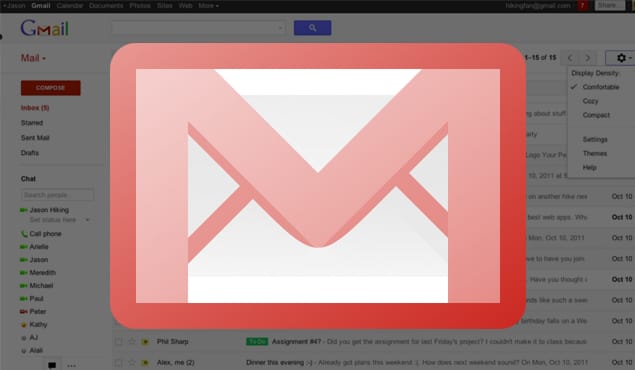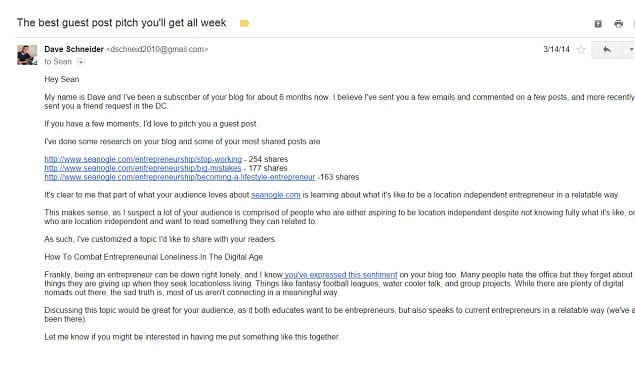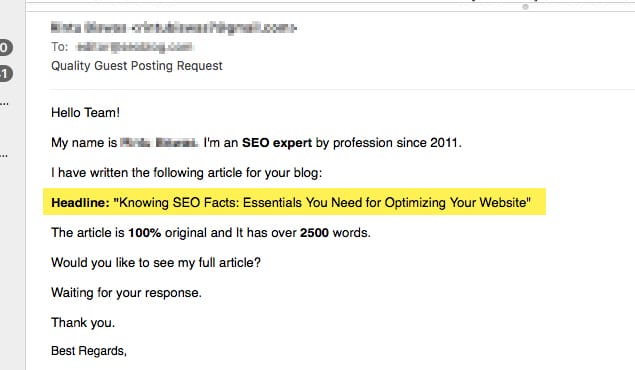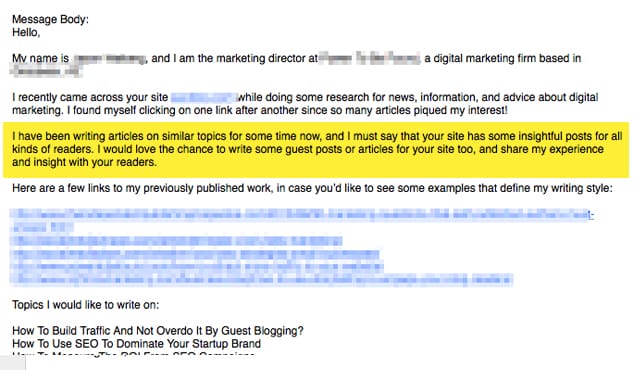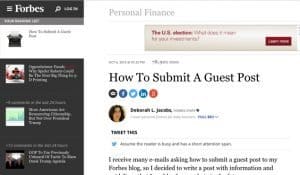Writing a guest post is touted as one of the best ways to grow a brand, increase readership, and make lasting connections in your industry. All that is very well and good once your post is live, but there are a handful of steps that must be taken before your name appears on your favorite blog.
The first, of course, is simply picking an industry. I’ll assume you’ve picked your niche or decided to turn to guest posting as a way of promoting the skills you already have. After that you’ll need to research blogs in your niche. Hopefully you already know of a couple (it is your industry, after all), but it’s good to really dig in here. Find a scope of blogs—from huge blogs you maybe hope to write for some day, down to the little guys trying to make it, just like you. This guest posting thing is a multi-pronged approach, and you’ll need to build relationships with everyone.
After doing those two things you’ll come to the actual guest post step. It’s time to pitch an idea or three to the blogs you’ve selected. You’re sitting there with your email draft open, unsure of how to begin. It can be a little like applying for a job. It’s nerve wracking to put yourself out there for something you care about, especially when your writing is on the line.
I get it.
Here are 6 email techniques to use when submitting that guest post. Make sure to follow each of these according to what fits the site you’re hoping to write for. At the best, you’ll get a resounding “Yes! Write that up” from the editor, and you’ll be on your way. At the very least you’ll be regarded as a legitimate guest post requester, which will eventually lead to publication:
1. Follow the guidelines of the site you’re submitting to
The first order of business is knowing the ins and outs of the site you’re submitting to. The bigger sites that produce a lot of content, or those individuals who run well-respected sites, will often have a clear set of submissions guidelines.
You can usually find this under a “Submissions” or “Work With US” page. If nothing like this is present (it’s hard to give exact examples for millions of websites!) head over to the About section. Often this is where the company or individual will let you know if they’re accepting guest posts and how they’d like to receive those posts.
When you find the blog you’d like to write for does have a specific set of guidelines, follow them exactly. Really. Either the editor or founder spent at least one late night typing up these guidelines for you. They are well-known enough to be tired of getting ridiculous emails from people who can’t write on topic or well, but they still want to hear from you. That’s only true if you follow the rules.
This isn’t a time to get creative, strut your stuff, or find counter-culture to be revolutionary. Upon reading a guest post submission or email subject line (often they will only read the subject line) that does’t follow the rules, editors and founders will literally mark it as spam or throw it in the trash. If they mark your first email as spam, they certainly won’t get the next one.
Think of it as common courtesy and follow their guidelines to the absolute best of your ability. If there is some aspect you cannot follow, explain why in the email itself. Write something akin to “I’m aware this part of my guest post submission does not follow xyz in your guidelines. My apologies, I am unable to…”
You get the idea.
If they don’t have guidelines…
I hear you already yelling the question, “But what if they have no guidelines?!” Don’t scream at me, please. It’s unbecoming of a guest poster. Keep calm, it’s going to be alright.
This is a good thing. It’s better, in fact. If the blog you want to write for does not have guidelines, it typically (but not always) means they are not overwhelmed with emails about guest posting. This by default increases your chances of getting accepted.
If they have no rules at all and simply state “We accept guest posts, please email us here,” send them an email that follows the next five techniques. You’ll want to standout in every way and you just won’t have such strict protocol to follow, which is a good thing.
If you don’t even know if they accept guest posts, I recommend sending your guest post email as you normally would, but prefacing the body of your text (after a brief hello) that says you’re unsure if they accept guest posts, but would like to contribute if they are. This may get you into an organization that usually doesn’t accept contributions, which can also be excellent for your career and business.
2. Be clear with your email subject line
After checking guidelines the next part of your email will be the subject line. Imagine you’re an editor at a big website. You probably receive anywhere from 100-500 emails per day. Some are spam, some are leads you have to follow up on, some are cute pictures of cats, and some are guest post requests. As the editor, you’d want to know exactly when a guest post request is a guest post request, and you’d want to know immediately.
When the guidelines tell you what to include in a subject line, do exactly what they say. For sites that don’t specify, an email subject line should start with the words “Guest Post Request” or “Guest Post Submission”. This lets them know immediately what the email will entail.
You do not, in any way, want your email to read like click bait. I’ve read some articles that advise you to put the catchy title of your article in the subject line—in my experience this will not go over well. The editor might think it’s a link to a published article from a competitor, or might view it as spam.
After typing in “Guest Post Request,” include a colon, then include the subject you hope to write about, or the name of the article you’ve already written. I’ll get into whether or not you should write your article beforehand below, but for the subject line put whichever option works best for you. Here are examples:
- Guest Post Request: 1200 Word Article on How to Catch Salmon, For Your Consideration
- Guest Post Request: 15 Ways to Catch Salmon in the Yukon
Those are just examples, I don’t know nothin’ ‘bout salmon fishing in the Yukon. Or the Yemen. The first explains what kind of article you want to write, the second what kind of article you already wrote.
Don’t include your name in the subject line unless you’re a big-name author. If that’s the case, you probably already know how to do all this. Your name will not matter and takes up precious reading time for that editor.
3. Include Pitches and Ideas In your Email
In order to write a subject line like I’ve instructed above, you will need to know what kind of article you want to write. This step will require a good deal of research, just like finding what blog you want to write for and if they accept guest posts or have submission guidelines.
What you want to write, and what you’re capable of writing, is the most important aspect of guest posting. If you come up with well-researched topics in your genre, execute them with witty words that make readers grin and join in a fell swoop, and establish relationships along the way you will have no problem in this field.
That said, it’s not easy. To get accepted for a guest post you’ll want to pitch ideas that are informative, unique, and address the specific user-base of the blog you’re pitching to.
This is a good moment for a disclaimer: Do not pitch generic posts to multiple blogs! This is obvious, lacks research and enthusiasm, and will put a bad taste in the mouth of whichever editor has to deal with your email.
Each and every blog has their own niche within a niche market. Make sure you understand the one you’re hoping to guest post for, and pitch a topic that hits that right on the head.
This can be done in a variety of ways. A good preliminary way is to use keyword tools like Uber Suggest to hone in on a unique keyword topic. Another way is to patrol the discussions and comments on the blog you’re looking at to find topics actual readers have requested to know more about. You can even relay this information in your email.
Finally, you’ll want to read the blog itself. This may sound obvious, but many people don’t do it. When you’re submitting to a blog make sure to read a large number of articles on that blog, from different authors and dates, including guest posts and sponsored content. Get a feel for what is expected of a post so that your pitches will already fit with the style of the blog. This will make it easy for editors to respond with a “Yes, go for it.”
Formatting the Pitch
This is simple. Include 2-4 pitches in your email; each can be a variation of the other, but differ them enough that they could be multiple posts. Either type the positive points in bullets or with a small paragraph. Don’t go into too much detail. Write it like a thesis, in that it is based on research, has a point, and is outlined in specific ways. Finally, include a proposed headline that rocks and fits the style of the blog you’re emailing.
On Writing the Guest Post Before You Write the Email
I’m sticking this here because if you’ve already written the article you’ll say that instead of including a pitch. I recommend that you do not write the article before you’ve gotten approved for the article. Of course, if the guidelines ask you to do this, then do it.
However, spending the time it takes to research and write a post for a specific blog without ever communicating with that blog just takes too much time. Sure, there’s the mentality that you’re so dedicated you stayed up all night and don’t even care if it gets published. You wrote it. Here it is!
If you present your article with that mentality you’ll come off as presumptuous and cocky or, conversely, groveling. Your time is worth something, no matter who you are. While some few editors or founders will like this and call it tenacity, most will be upset that you wrote a whole article without their input, because they’re going to ask you to change things anyway. Another bunch will be upset because it puts a little more pressure of them to publish the article, and they don’t want that.
4. Talk About Why You Want to Write for That Blog in Particular
Either before or after your pitches (I leave the order to you, go with the flow), include why you want to write for them. Don’t talk about how much it could do for you, just like a job interview. Talk about them. Not to butter them up, but to relate all the research you did about them.
Mention recent articles on their blog that were informative, and relate your own pitches to those articles. Mention authors you respect on the site and show you have a broader understanding of the genre. Finally, give specific reasons you want to write for that blog, and never say you hope to gain more followers or subscribers.
You are contributing to a larger network here, and you need to be both aware of that network and of your ability to improve it. State these things clearly and respectfully without being pretentious.
Lastly, use the person’s name in the email. You should know the name of the person you’re emailing — if you can’t find it, search harder to find it.
5. Be clear about yourself
As you can maybe tell, there are three sections in the body of the email. Your pitches, what you like and respect about the blog you hope to contribute to, and who you are. This last bit is important.
This might make you worried, but there’s no need. You don’t need to be a big name author with thousands of followers to get accepted as a guest post author. The system wouldn’t work if that were the case.
You do need to give your name, the website you have or work for, and what your expertise is. If you don’t have a website or work for one, talk about what your passions are jobs are and how they relate to the blog’s industry. It’s helpful if you already have some following or presence, just because this assures an editor you’re serious. It also allows them to look you up easily.
If you’re really starting out at the very bottom, say that you are. Be honest. They started out there too, and your honesty will trigger that memory for them. Don’t promise somebody you’re not, but also state your desires with conviction.
Oh, and—
6. Include Links to Published Work
The final step in this email extravaganza. You have to include examples of published work. Again, don’t freak out. We live in the digital age and “published” just means articles that are online somewhere. It can be your own blog—yes, you can start a Blogger for free, publish three articles, then link to those in a pitch email. That is absolutely legit.
I also suggest you create a Medium account and publish some articles there. It’s better if you have articles at a bigger name site, but not necessary. Also, there’s the content of the published articles to consider. If you have articles up at a recognized website that has nothing to do with the blog you’re trying to write for, it has less impact. Include it with a note that says “I know this isn’t in your genre, but it’s an example of my writing skills.” Always include at least one published article that’s in the genre.
Do not attach a Word document with something you’ve written. Don’t do it; please don’t. Just don’t.
Ready for that Email?
You better be, because this was a long article on how to do it right. The above should be followed for your first email to an organization—not your second, not your third. Don’t send an email that’s titled “Hey, Do You Take Guest Others?” with a body that says your name and favorite hobbies. Be professional about this and you’ll go far.
One last tidbit of advice: Be nice. Use their name, express thanks and appreciation, have a personality. Nobody wants a robot writing articles, and you’ll only be interacting on email to start out with, which is notoriously bland. Be courteous and be a human, alright?
Now get out there!
 ContentPowered.com
ContentPowered.com
